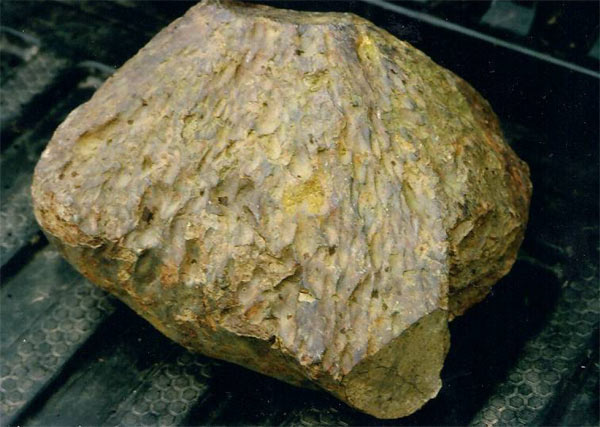Ancient 40-pound Meteorite Pulled From Ditch in Oregon

This article was updated at 3:45 p.m. ET.
A seemingly normal rock found in a ditch along a stretch ofroad in north central Oregon has turned out to be a stone from outer space thattravelled across millions of miles and billions of years to reach Earth,according to researchers studying the stone.
The 40-pound, cone-shaped space rock, which is about thesize of a beach ball, was picked up by Donald Wesson and his wife Debbie duringthe fall of 1999 as they drove through Oregon's wheat country on their way hometo Washington. It is the fifth meteorite to be found in the northwestern state.
The spacerock, which sat anonymously on the planet's surface for a few hundred to athousand years, remained unidentified for another decade as it rested in Wesson'sgarden.
Only after spending time beneath a deck barbeque, visiting acounty fair and passing through two universities did it receive the officialclassification as a meteorite. [Meteoritecraters on Earth.]
"It was probably plowed up by a farmer and tossed tothe side of the road," said Dick Pugh, a geologist at Portland StateUniversity in Oregon. "There is even evidence that the rock was hit by aplow."
Space rock's tall tale
Breaking space news, the latest updates on rocket launches, skywatching events and more!
Wesson finally began asking around after watching atelevision program about meteorites.He took the rock to a local county fair in Castle Rock, Washington in thesummer of 2009, where he spoke with a member of the Southern WashingtonMineralogical Society.
The find was referred to Western Washington University inBellingham, Wash., where initial sample tests showed it was probably ameteorite. Final confirmation came from the Cascadia Meteorite Laboratory atPortland State University, which classified the Morrow County meteorite as anL6 ordinary chondrite that had been highly shocked (S5) but minimally weathered(W1).
The latest find represents a relatively common type ofmeteorite, according to Melinda Hutson, a planetary scientist at Portland StateUniversity who helped make the classification. But, she added that it hasseveral intriguing features.
"The meteorite isn't significantly weathered, but ithas a distinctive yellow tint caused by weathering unlike that seen inmeteorites recovered from deserts in Africa or Antarctica," Hutson said."Also, it has beautiful shock veins and glass, caused by a major collisionin space."
Based on its type, the Morrow County meteorite was likelyformed approximately 4.5 billion years ago, said Alex Ruzicka, a planetaryscientist at Portland State University.
"Given the kind of meteorite that it is, and the shockeffects that it experienced, it probably started its travels to Earth from theasteroid belt about half a billion years ago," Ruzicka told SPACE.com.
Morrow County meteorite
Both the name and classification of the meteorite havereceived official approval from the Nomenclature Committee of the Meteoritical Society,and a type sample now resides with Portland State University.
Meteorites can easily remain anonymous in Oregon's heavilyforested lands west of the Cascades, and many dark-colored volcanic rocks tothe east of the Cascades look similar to real, dark-colored meteorites.
Dark bedrock geology and high levels of precipitationtranslate into 34 times fewer meteorites recovered in Oregon per square milethan in Kansas, a state with light-colored bedrock and very little forest. Butthat has not dimmed the confidence of Oregon's meteoritehunters.
Previously, only four meteorites have been recovered from Oregon,including Sam's Valley, found in 1894; Willamette, found in 1902; KlamathFalls, found in 1952; and Salem, which fell in 1981. Three of these are ironmeteorites, whereas Salem and the newly classified Morrow County are both stonymeteorites.
The Morrow County meteorite is substantially bigger than theSalem fragment, which is only a few centimeters across, said Ruzicka. The Salemmeteorite was found by a policeman, after it hit the roof of his car in thelate evening while he was off duty.
"In a way, I'm not surprised at all by thisdiscovery," Ruzicka said. "With our vigorous outreach effort I alwaysknew the lab would help to recover more meteorites from Oregon, I just didn'tknow when. Maybe this will be the start of many more to come"
- Gallery- Earth's Meteor Craters
- Images- The Best of Leonid Meteor Shower
- Video- Meteor's Fall Caught on Camera

Space.com is the premier source of space exploration, innovation and astronomy news, chronicling (and celebrating) humanity's ongoing expansion across the final frontier. Originally founded in 1999, Space.com is, and always has been, the passion of writers and editors who are space fans and also trained journalists. Our current news team consists of Editor-in-Chief Tariq Malik; Editor Hanneke Weitering, Senior Space Writer Mike Wall; Senior Writer Meghan Bartels; Senior Writer Chelsea Gohd, Senior Writer Tereza Pultarova and Staff Writer Alexander Cox, focusing on e-commerce. Senior Producer Steve Spaleta oversees our space videos, with Diana Whitcroft as our Social Media Editor.
